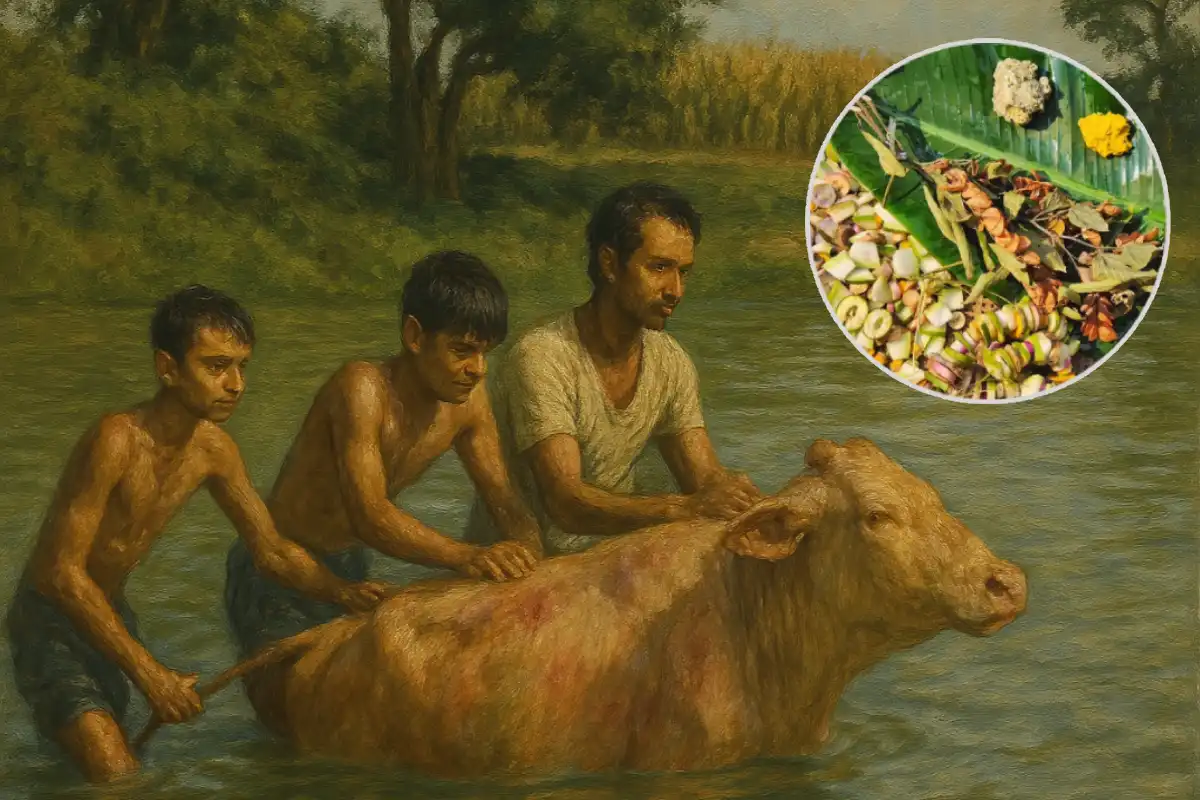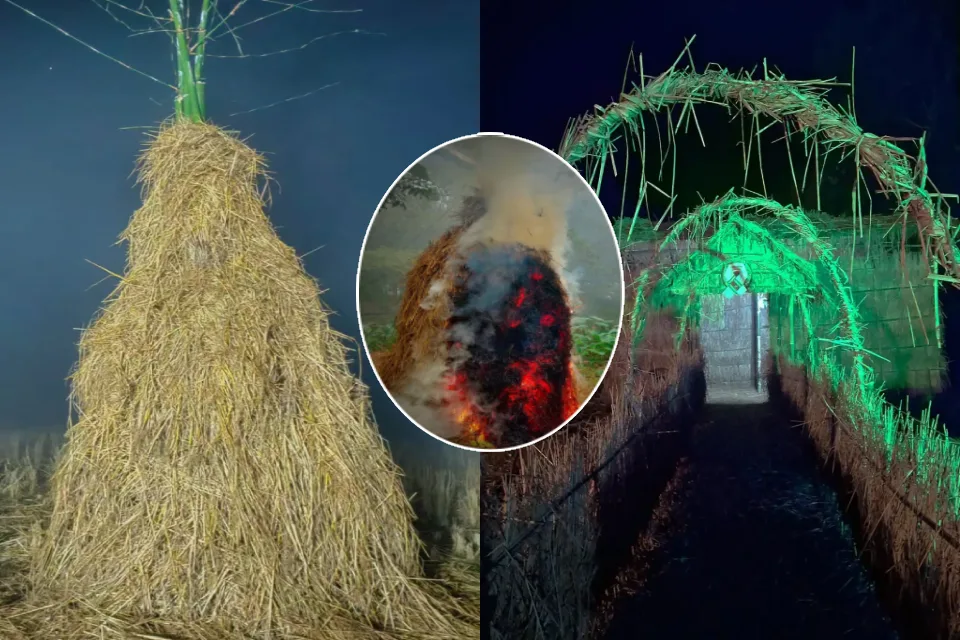Pampering cows, payers, and feasting—let’s explore the fun celebration of Goru Bihu with its rituals and significance in Assamese culture and agrarian heritage.
Updated on :
Share this post
Goru Bihu, meaning ‘Cow Bihu,’ is the first day of the Bohag Bihu festival in Assam, which is dedicated to bathing and worshipping cattle.

Prior to the commencement of Bohag, it is celebrated on the final day of the Assamese month of Chot. The cattle are brought to nearby ponds or rivers by their owners, where they are properly bathed, decorated with colorful cloth, and adorned with flowers, and farmers offer prayers to the cows for their well-being and prosperity. It symbolizes Assamese agrarian heritage and respect for cattle.
Let’s Explore the Customs and Rituals of Goru Bihu
Rituals of Goru Bihu
The principal ritual performed in villages on Goru Bihu is the washing and care of cows and bullocks. Farmers are not the only ones that celebrate Goru Bihu; people from all walks of life participate in the celebrations. Throughout the day of Goru Bihu, every spiritually inclined family performs a series of ceremonies for the benefit of bullocks and cows.
Goru-Ga-Dhuwa
The Assamese word goru means bullock or cow. Washing and caring for bullocks and cows is the main mandated ritual performed on the day of Goru Bihu. A variety of vegetables, such as bottle gourd, brinjal, cucumber, bitter gourd, turmeric, sweet potato, and Borthekera, are sliced by the male family members. The vegetable slices are then sewn together using a standard bamboo strip tool, and it is called chaat or chaatbari.
Once prepared, a banana leaf is placed atop a Dola (a dish-shaped bamboo utensil) to hold multiple of these Chaat, depending on the quantity of cattle. After that, the chaat is stored separately from lumps of black-gram paste, fresh turmeric, Borthekera, and a mixture of ash and oil (castor or mustard).
Typically, the women in the family prepare these dishes. And finally, one or two branches of Makhioti (Flemingia Strobilfera) and Dighlati (Litsea salicifolia) plants and new ropes to tie cattle are also kept with the Chaat. Following the completion of the previous preparations, the family members pray to God and rub the cattle’s bodies with some of the paste. The ash and oil mixture smears the forehead, horns, and hooves. Sliced vegetable garlands are used in some locations to adorn the cattle.

After making various preparations, the male members accompany the cows and Dola to a nearby water source. Cows are driven from their residences to the water source with the branches of the medicinal plants Makhioti and Dighloti, which are used to carefully strike the animals. Cattle are supposed to be significantly protected against a range of pests and diseases throughout the year by doing this.
“Lao kha, bengena kha, bosore bosore barhi ja; maar xoru baper xoru, toi ho bor goru”
While throwing chaat (vegetable slices) at the cows, a traditional chant is ushered for their welfare. On the day of Goru Bihu, every family uses the same paste to take a bath. In certain areas, people bathe, ideally in the same water source, and pray at Namghar, a communal house of worship, on their way home.
Cattle are tied in the cowshed in the afternoon using fresh ropes, usually made from the Tora plant. After that, a medicinal smoke is set up for the cows and bullocks close to the cowshed. Burning rice bran and the twigs of other medicinal herbs, such as Dighloti, Makhioti, and Puli-kaint (Maclura cochinensis), produces this smoke. Then each of the cows is fed with a special kind of laru (sweet balls) made of rice flour and molasses or salt.
Also Read: Magh Bihu Uruka: A Fun Night of Joy and Social Bonding
Keeping Chaat, Makhioti and Dighlati

After bathing cows at a community water source, each family returns home with a partially used Chaat as well as used branches of Makhioti and Dighlati. These things are maintained in safe places in the cowshed and house in the idea that they will protect cattle and family members from pest diseases and other events throughout the year.
Feasting Cuisines of Chaat
After throwing at cows, people gather the vegetable slices to make unique dishes with therapeutic benefits, especially a curry. Usually, it is prepared with eggs. In addition to being incredibly tasty, this food has significant medicinal advantages.
Adorning with Jetuka
Women apply jetuka, or henna leaves, on the evening of Goru Bihu. Young leaves from the jetuka plant are used to form the paste that is applied to the palm, toenails, and fingers. Not only does applying jetuka paste to the hands and feet make them more attractive, but it also helps prevent diseases brought on by mud and muddy water. Men in some households also put jetuka paste on their thumb and big toenails.
Starting of Hunchari
The most organized and disciplined Bohagh Bihu program is called “Hunchari,” and it features dances accompanied by music. It is a program that has spiritual significance in addition to being entertaining. In the evening of Goru Bihu, it is started in family courtyards with specific ritualistic actions and an auspicious atmosphere.
Feasting Medicinal Cuisines
Feasting on traditional cuisines of medicinal value is regarded as an important ritual of Goru Bihu. It is believed that eating these cuisines on the day of Guru Bihu is beneficial for boosting immunity and keeping a person healthy for the year. Either a curry of 101 herbs is prepared or the one with 7 herbs.
Endnotes
For the people of Assam, Goru Bihu is a day of immense significance and festivity. Cows are considered to be sacred animals as the agricultural season begins. The celebration unites people to appreciate life’s little pleasures and symbolizes Assamese culture.
For the people of Assam, Goru Bihu is more than simply a celebration; it is a way of life that captures the spirit of the state’s rich customs and culture.

Rimjim Bora is a passionate researcher, writer, and storyteller. Being an Assamese, she takes pride in writing the vibrant stories of Assam, sharing its essence beyond the region. Contact Rimjim at rimjim@diversityassam.com.


